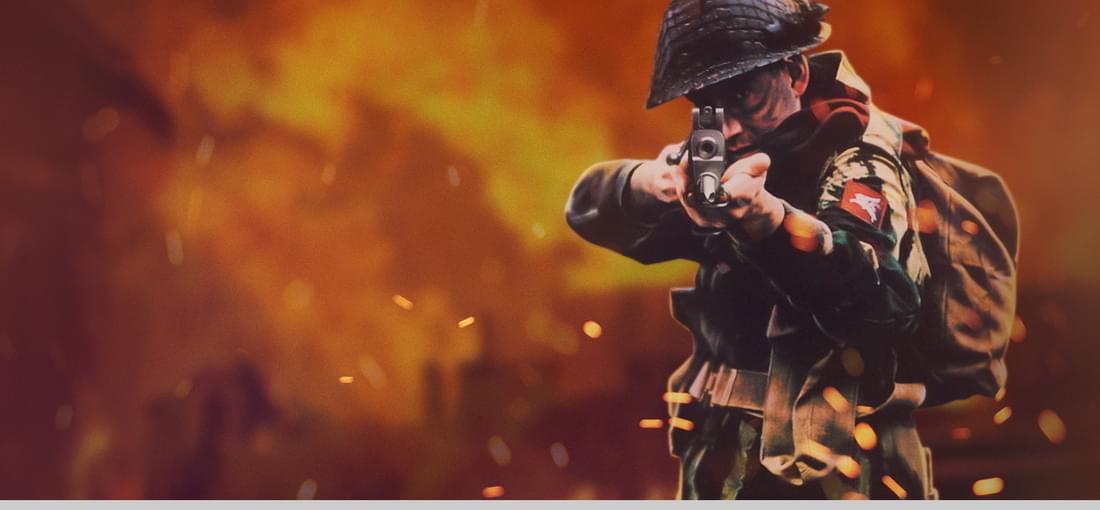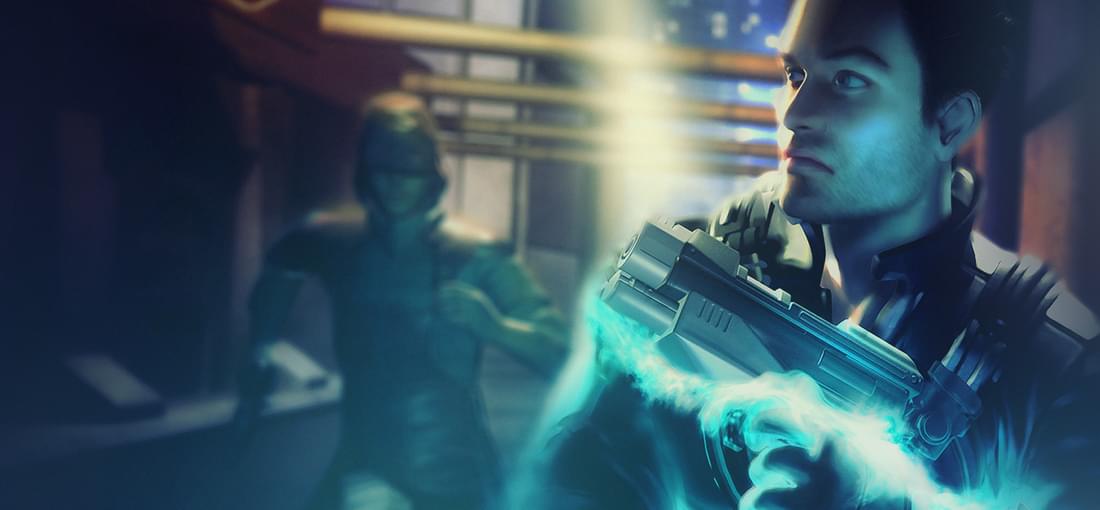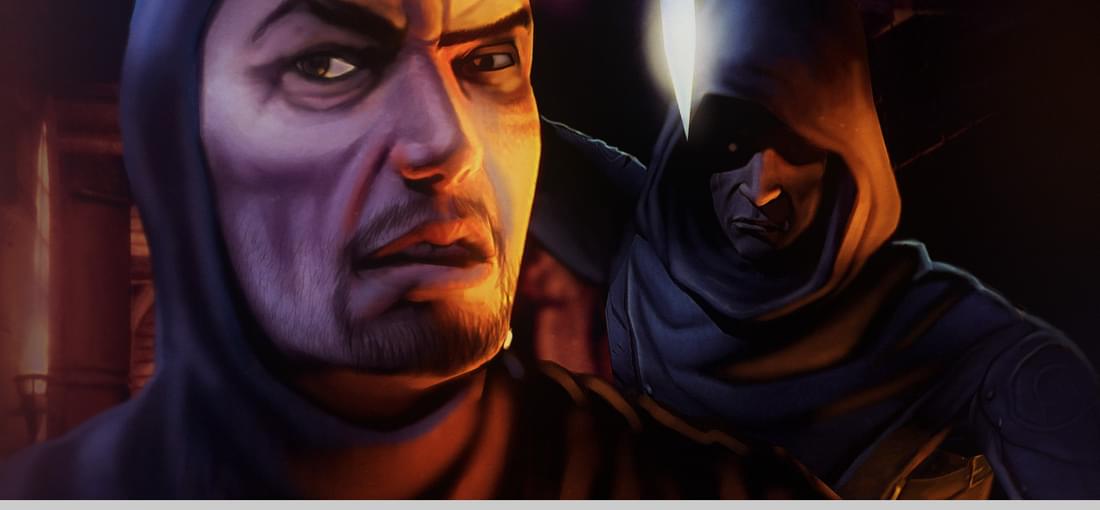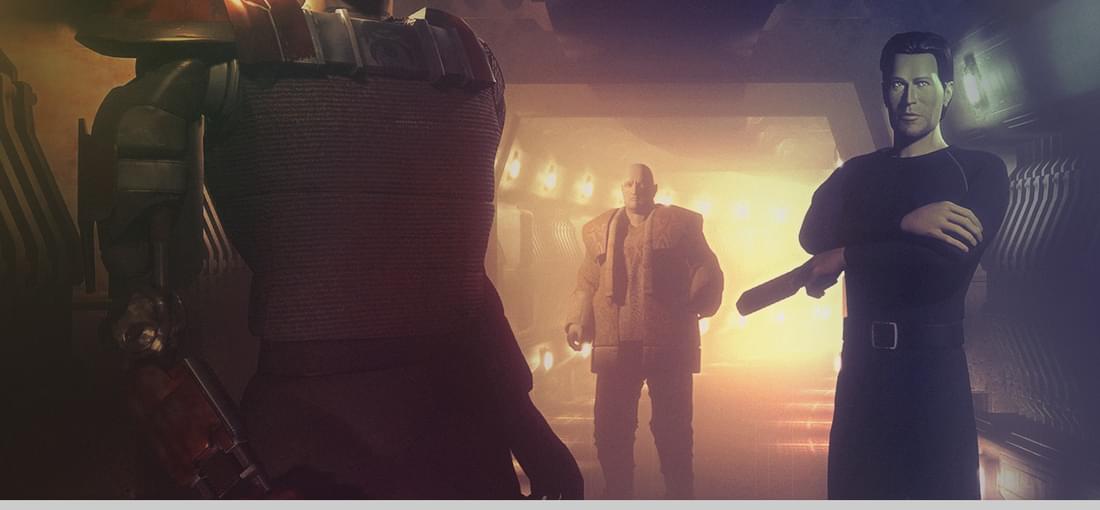


Hidden & Dangerous is a flawed masterpiece, an ambitious and innovative title featuring graphics and gameplay ahead of its time and some of the most interesting missions ever seen in a first person shooter. Ultimately the gameplay doesn't completely deliver on its promises--due mainly to some AI limitations and an inhuman level of difficulty--but there's a charm and mystique to this game that has always made me forgiving of it's faults. You begin each mission with four soldiers and you can switch between them at will. You can also pause the action at any time and go to a map screen (displaying a 3D miniature of the whole level) where you can queue up orders for your men as if you were playing a top-down strategy game and then watch those orders play out from a first-person or third-person perspective. The interface works very much like the tactics stage in the early Rainbow Six games except here you can access the map screen and modify orders at any time during a mission. Mission objectives involve blowing up targets, freeing prisoners of war, or simply getting through an area alive. In some of the most fun missions, you need to hold off dozens of attacking enemy units until a rescue boat or plane arrives. Despite the complexity of some of the missions, Hidden & Dangerous contains the clearest and most impressive mission briefings I've ever seen in a game. The only major criticism I have with the game is how difficult it is. There is a choice of difficulty levels, but even on 'Easy', the enemy never fails to spot you and only requires a few shots to kill you. On top of that, half of the enemy soldiers carry sniper rifles, so it's much too common to get shot the instant you come into range, before you even know what hit you. What's the bottom line? If you enjoy realistic tactical shooters, if you like WWII themed games, if you love it when a plan comes together, then I feel confident that you will get at least some enjoyment from Hidden & Dangerous.

When this game was released, it received immediate criticism from PC gamers as a textbook example of how designing a game for multiple platforms negatively affects the interface, gameplay, and depth that people expect from a quality PC game. In my opinion, those criticisms were exactly right. --- The original Deus Ex was a supremely memorable game with large interesting environments, compelling characters, deep gameplay, and an epic storyline. Invisible War, by contrast, is mostly forgettable. The map environments are tiny and unconvincing. The characters are one-dimensional. The gameplay still has some depth, but it is simplified in almost every regard. And the story starts off promising but then never delivers anything compelling. With the exception of visual quality, the original Deus Ex is--to this day--a better game in every respect than Invisible War. --- Invisible War stays relatively in line with the first game's unique approach of providing multiple paths to each objective. In most situations, you can choose to fight your way past human enemies, hack your way through electronic defenses, sneak around and search for alternate access points, or some combination of these tactics. But in Invisible War everything is on a smaller scale because the maps are so much smaller. This lack of space seriously undermines the open-ended gameplay; there's only so much sneaking or exploring you can do when the entire level is comprised of four rooms and a hallway. --- Most of the areas are not just small, but also feel very artificial, not like real-world locations. As a result, even though the visual quality of the graphics is better than the original Deus Ex, I found it a much less immersive experience. In the original game, you could step through the gate of a fully guarded military base or airfield and the size and scope of the environment and its defenses would take your breath away; nothing in Invisible War will leave you awe-struck like that. Worst of all, the loading times between levels in this game are way too long considering how tiny those levels are. When you realize you need to backtrack a few maps to finish a secondary quest, you will begin counting load screens in your head and wonder: "do I really care that much about finishing this quest?" --- Like the original Deus Ex, this game attempts to pull you into a universe where powerful organizations are competing for world-power and for your allegiance. Unfortunately, in this game I never felt like I had more than a basic understanding of what each organization stood for. On the one hand, I like that the quest-giving organizations are not presented in stark terms of 'good and evil' like in most games. But you're given so little information about each organization and there's so little dialog dealing with the moral considerations that I have to conclude that the sense of moral ambiguity in this game is more the result of poor storytelling than anything else. There are a few twists in the story, but if you've played the first game, most of these revelations are so obvious that you'll already have figured them out within the first hour of the game. --- Every time I thought the story was going to develop into something epic or interesting, it fell flat on it's face. For example, mid-way through the game, characters start mentioning a mysterious key figure who no one has been able to find in 15 years, and your primary quest becomes to find that person. Sounds like an exciting journey that will require interrogating people, gathering clues, and traveling to some perilous remote location, right? Actually no. Instead, my pilot drops me off in a town, recommends that I 'begin my search' in the bar next door and when I walk into the second room of that bar, the guy I'm looking for is standing there. --- That character happened to be someone who was also in the original Deus Ex. A lot of characters from the first game reappear in the sequel, but in almost every case their personalities and actions didn't match what I remembered of them from the first game, and many of the characters seemed to lack any personality at all. I was actually angry at how one of the key characters from the first game was presented here (and I'm sure I'm not alone). --- There are a few signs of genius in the writing. Like the first game, the dialogue occasionally touches on some thought provoking sociopolitical concepts. The conversations with the pop-star AI kiosk were for me the high point of the game. Overall, the voice acting is pretty good, especially the female protagonist. I liked that you could choose to play as a male or female character, however this didn't appear to make the slightest difference in how other characters responded to you. --- The combat mechanics in this game are a little clunky, especially when dealing with multiple enemies at once (that was also a weakness of the original Deus Ex). As in the first game, a combination of stealth and deadly force generally provides a more satisfying experience than running in with guns blazing. --- I know I've spent a lot of effort comparing this game to it's predecessor. But even if the original Deus Ex had never existed, I don't think I would consider Invisible War a game worth much attention. The bottom line: this is a mediocre shooter with decent stealth gameplay and a unique storyline which touches on some surprisingly deep ideas. But the ridiculously small maps, long load times, and ultimately unsatisfying story make this a game that I cannot recommend to anyone.

Thief: Deadly Shadows is the third game in the Thief series. Whereas the first two games in the series were released soon after each other and used essentially the same graphics engine, Deadly Shadows came out a number of years later, used a brand new graphics engine, and was the first game in the series to be developed for multiple platforms (not just the PC). --- The new graphics engine results in this game looking much nicer than the previous Thief games. More importantly, this engine delivers even better lighting and shadow effects than before. This is also the first game in the series that lets you play in 1st person or 3rd person perspective, and I thought both were implemented very well. (I particularly liked how while in 1st person view, you could look down and see parts of your body.) Other improvements over Thief II include ragdoll physics (for the unconscious bodies you carry around), the ability to put out candles (as well as torches), and a new mini-game for picking locks. --- The core gameplay is very similar to the other games in this series, and many of the same weapons and gadgets are present, with some minor adjustments. For example, in Thief I and II, you had to hoist the blackjack over your head and then let it fall onto an enemies skull; this resulted in it feeling like it had substantial weight to it, and made each knock-out all that more satisfying. In Deadly Shadows, you just swing the blackjack quickly, and I felt like it had the weight of a wiffle-ball bat. On the other hand, shooting arrows in Deadly Shadows feels even more satisfying than before. When I play Thief I and II, I usually avoid killing any humans, but in Deadly Shadows I can't resist putting arrows through the necks of a few guards. --- The storyline is quite good, and resonates with the stories told in the first two games. The ending in particular brings the series full circle in a very satisfying way. The dialogue and acting are also quite good; the protagonist is voiced by the same excellent voice actor as before. --- The design of most missions in Deadly Shadows is pretty good, but the settings and objectives are not as interesting and original as those found in Thief I and II - with one notable exception! One mission found late in this game is widely regarded among PC gamers as the most interesting, creative, and scary "haunted house" level in any game ever. It's probably worth playing Deadly Shadows for that mission alone. --- Overall I found this game less challenging than the previous games in the series. Once you've mastered the basics of stealth gameplay, taking-out a lone guard with a simple patrol route is child's play; the challenge comes when you encounter multiple guards watching each other's backs or guards with long, complex patrol routes. Unfortunately, Deadly Shadows didn't deliver many situations like that. Even on the highest difficulty, I found it pretty easy to blackjack one guard after another without requiring much planning. --- My biggest complaint with this game is that each map area is much too small, and most missions are broken up into several small map areas which makes the game world feel artificial and really hurts the level of immersion. One of the most innovative things the game does is present a "city" area that serves as a hub; to get from one mission to the next, you sneak through the city, avoiding guards and pick-pocketing civilians as you go. This was a wonderful idea in theory, and if they could have built the city as a single map area it would have tied the game world together nicely. But instead the city, like the missions areas, is broken up into half a dozen tiny maps with noticeable load times between them, which made me eventually hate the whole idea. The last third of the game involves a lot of crisscrossing back and forth through the city, and by the end, I was sick of having to sneak through the same areas so many times and REALLY sick of watching loading screens. --- A few other minor complaints: The objectives screen, while very useful during a mission, is displayed in a ridiculously large font, had no option to hide completed objectives, and required a stupid amount of scrolling as a result. Another frustration was that several times I got stuck on the geometry in the world; this never required me to reload but usually did require 30 seconds of loudly and awkwardly jumping and strafing to get free. Now granted this only happened when I was in unusual spots, like up in the rafters or slipping behind a piece of furniture, but a stealth game should reward--not punish--that kind of exploration. Finally, while I thought the lock-picking mini-game was a slight improvement over the way it was handled in previous games, I found it bizarre that the game reused the same lock-pick combinations over-and-over again (that should have been the simplest thing in the world to randomize). --- So what's the bottom line? The small maps and frequent load screens prevent me from giving this game a ringing endorsement, but if you are already a fan of Thief I and II, I think you will enjoy Deadly Shadows as well. It is true to the spirit of those games, further develops the overarching storyline of this series, and it gets most of the stealth gameplay elements right. If, on the other hand, you've never played Thief I and II, you should play those first, BECOME a fan of them, and then come back to this one.

The gameplay in Indigo Prophecy is a combination of simplified adventure gaming and quicktime-event driven cutscenes. What is most notable about this game is the above-average writing, movie-quality camera work, and outstanding 3D animation that accompanies almost every scene and weaves the two gameplay styles together. The storyline is also very engaging until the last third of the game when it goes completely off the rails and concludes with one of the worst endings imaginable. What do I mean by "simplified adventure gaming"? Picture a typical adventure game, but take away the puzzle solving, inventory, and backtracking between locations. In Indigo Prophecy, most of the time, a character will tell you exactly what needs to be done next, then you walk across the room and get prompted by the game to carry out that action. There are a few situations that allow you some creative thinking, but even then everything is so straight forward that I wouldn't describe it as 'puzzle solving'. I dislike most adventure games because I get stumped easily, so this style of play was actually more my speed. But I think most hard-core adventure gamers will view the 'adventure' sections of Indigo Prophecy as being devoid of any challenge. However, that's only half the game. The rest of your time will be spent in long, visually exciting cutscenes requiring constant feedback from you in the form of quicktime key presses. This is the first game I've played that featured quicktime events. I know some video game critics are outspoken in their hatred of this style of gameplay (Ben Croshaw of Zero Punctuation amusingly refers to quicktime events as "Press X to not die!") In Indigo Prophecy, despite the fact that the indicators were superimposed right on top of the cutscenes and despite the fact that I kept the game difficulty set on 'low', I found it almost impossible to concentrate on the keys I had to press AND pay attention to what was happening in the cutscene at the same time. The few times I did manage to do both, it seemed like the game designers had done a really nice job of syncing up the keys you were pressing to what your character was doing, but I can't help feeling that their efforts were a waste of time. It seems a shame that programmers, animators, and motion-capture actors did so much work on these interactive cutscenes, while I could only appreciate a fraction of it because I had to concentrate on pressing keys the whole time. The storyline is oddly the best AND worst aspect of Indigo Prophecy. The first two thirds of the game develop a wonderful story. Then it starts to go downhill fast. I won't go into detail (to avoid spoilers), but suffice it to say that the plot goes so far off course that it barely resembles the same story. The last few scenes are so astonishingly bad that they nearly destroyed my overall opinion of the game. The game is also pretty short, it will probably only take you about 8 hours to complete. The production values are top notch. The theme music is beautiful and the voice acting is very good. The motion capture animation is outstanding, and the facial expressions and mouth movements look very convincing. The 3D graphics that make up the world are attractive enough and realistic looking enough to support the cinematic feel of the game. During conversations and cutscenes, the game uses all sorts of creative camera movements to add drama to the scene; I especially liked the frequent use of multiple camera views on screen at the same time (like the television show "24"). One interesting thing that Indigo Prophecy does (which you don't see in many games) is have you control different characters in different scenes, in some cases characters who are working against each other. And in a few cases, you can even switch control between two characters in the same scene. The game includes many fully voiced conversations. At various points in each conversation, the character you are controlling will have a short amount of time to choose from three or four possible responses. These conversations were my favorite part of the game; in a few of them you really needed to use your head. For example, in one of the best scenes, you control a guilty man being interviewed by a suspicious police detective and need to decide what to lie about and what to tell the truth about to keep from raising suspicion further. I did get frustrated at times with the controls used to move your character around. The game would frequently and suddenly switch between areas where you could rotate the camera and areas where you couldn't, which got very confusing. And the camera angles it would choose for you were often very poor. Also, I think that pressing a forward key should always make a character turn and walk in the direction the camera is looking (not the direction the character avatar is looking) and left/right keys should strafe the character, not turn them; unfortunately, there was no option to have the controls function the way I wanted them to. Bottom line? You might want to try the demo before you buy this one. Most people will really enjoy the first few hours… just don't expect a long game or a satisfying ending. Also, if you hate quicktime events, this is not the game for you.

Independence War II is one hell of an ambitious game; it's part space combat simulator, part space trader, set in an enormous universe with a unique back-story. Once you get deep into the game, you'll find that it's heavy on story, heavy on combat, and a bit light on the trading. It's also extremely difficult. SPACE TRAVEL I can't say enough good things about the game engine and the way space travel is handled in Independence War II. The universe presented to the player is trillions of miles wide and contains over a dozen separate star systems made up of hundreds of planets and bases. And believe it or not, it's all precisely mapped out in a single 'star-map', which lets you logically cycle through all the available systems, planetary orbits, lunar orbits, and space stations. The interface is cleverly designed, allowing you to quickly browse through hundreds of possible destinations while still giving a sense of the immense distances between them. There are three methods of travel in the game. First is your ship's engines. Second is a sort of light-speed warp drive. And third is instant travel between 'Wrinkle in Time' style jump-points. A well designed auto-pilot system allows you to simply select a destination from the star-map and command your ship to take you there the quickest way possible, but you always have the option to fly there manually instead. The game does require some patience to get from one place to another; traveling from your base to the start of a mission generally takes about five to ten minutes. Incredibly there are no loading screens, even when traveling from one end of the 'known universe' to the other. The space travel and weapons technology portrayed in the game is well thought out, with a lot of clever touches - like how the game's fictional jump-point technology is associated with the real scientific phenomenon of Lagrange points, or how your warp drive can be disabled by dampening fields. These game mechanics provide a sense of scientific believability while also serving to enhance the gameplay. The game contains an extensive in-game encyclopedia which discusses many of these concepts, as well as outlining all of the spaceship technology available to you and providing a brief history of the star systems in your neck of the universe. STORYLINE Independence War II has a very engaging story. I'm not sure why I connected as strongly with the story and characters as I did. But from that opening cinematic on, I was on the edge of my seat. (I'm sure it helped that the cut-scenes and the voice acting are both of outstanding quality.) A lot of the story progresses through emails that you receive at your base, but there are also cut-scenes and radio communications scattered throughout many of the missions. I thought the game did a great job of telling a coherent and meaningful story while still allowing you to do many of the missions in whatever order you wanted to. The middle Act is especially good in this regard: it begins with one simple objective, to "find allies in other systems". And as you explore the universe and make new allies, that one objective snowballs into dozens of missions. Unfortunately, not all of the sections of the game provide as much flexibility as this middle Act. SPACE TRADING The other aspect of the game, the pirating and trading, is of course extremely open ended. Many different factions exist in the world of Independence War II (government, corporations, allies, enemy pirates, etc.) and they are all constantly moving cargo between their bases. All of that cargo is available for you to hijack, provided that you can deal with the escorts protecting it. At your base, you can trade captured cargo items for spaceship technologies and then add those upgrades to your ship. I found this part of the game to be very addictive; there are many ship upgrades available and it takes most of the game before you can obtain them all. I generally found myself alternating between storyline missions and freelance pirating expeditions. Unfortunately, the pirating and trading aspect of the game isn't quite as deep as it seems at first. You can't obtain more than three ships during the whole game, so once you've gotten your hands on the best ship and fully upgraded it, there's no point in pirating or trading beyond that. COMBAT The combat is unique compared to other space combat games. A realistic physics model and sense of inertia make it difficult to turn on a dime or reverse direction suddenly, so most of the time, you don't want to be flying forward at maximum speed. Your ship is also equipped with lateral thrusters, allowing you to strafe left and right as easily as forward and backward. The ship's maneuverability and the way you'll want to fly it is similar to the ships in the Descent series; you need to do a lot of circle strafing and dodging of missiles to stay alive. The biggest problem with this game--and it is a major problem--is that combat is very difficult and you cannot save your game mid-mission. Even after you master the necessary combat tactics and upgrade your ship pretty well, it's still surprisingly easy to die at the tail-end of a 20 minute mission. And boy does it suck when that happens several times in a row. In fact, the game is so difficult that even though I come back and replay it about once a year, I have yet to make it through the entire game without cheating. Each time I vow that I will not cheat, and I usually get a little further than before, but eventually I'll fail a mission several times in a row, get frustrated, and break out the cheats. PUZZLE SOLVING Another weakness of the game is that you often need to do things in a very particular way, but the objectives you are given don't get specific enough. For example, a number of missions require you to go steal a cargo pod from someone. In some cases, you are supposed to dock it to your ship and fly it back to where the mission started. In other cases, you are supposed to order your salvage guy to pick it up and take it back to your base. It's not always clear which you are supposed to do. Also, many missions require some puzzle solving to complete. For example, in most cases when you encounter an enemy base or capital ship, you can't just shoot the hell out of them; there's some secret weakness or clever tactic that you need to employ to take down their shields or get past their defenses. Your crew-members often drop some hints as to what you're supposed to do, but it still usually requires some experimenting, and you may occasionally get stumped. BOTTOM LINE If you love space combat games, welcome a tough challenge, enjoy a good science fiction story, and have some patience, then I recommend this game to you.